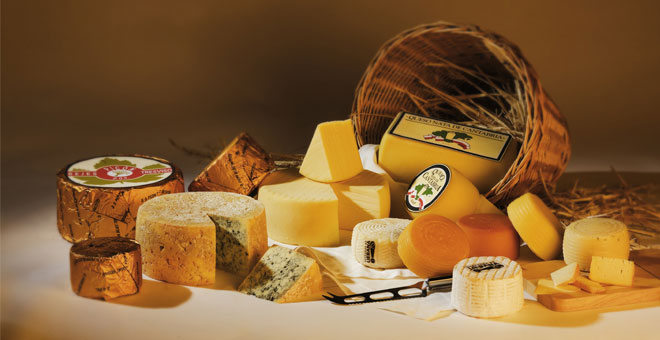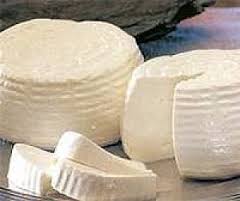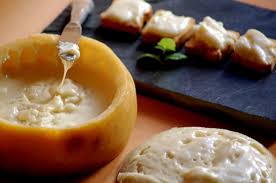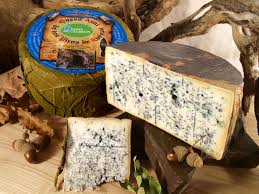
Spain’s diversity in terms of topography, soil and climate has lent itself to the emergence of ecosystems that are clearly suited for stockbreeding, whose origin dates back to ancient times. This has resulted in the wide variety of cheeses that are derived from native animal breeds.
The quality milk from indigenous breeds and the know-how of shepherds and cheese makers have given rise to a large range of top quality cheeses. The Spanish Inventory of Traditional Products, published in 1996 by the Ministry for Agriculture, Fishing and Food, includes one hundred varieties of cheese from all over the country. Of these, 28 have been awarded official Designation of Origin.
In the last two decades numerous artisan cheeses have appeared all over Spain. Many of them are original, innovative products and some are already well established, achieving prominence within the world of Spanish cheeses. This development has contributed to a rich culinary heritage that today now includes over 150 varieties of cheese.
Spain is experiencing a veritable cheese revolution, similar what happened with wine 30 years ago. It is important to bear in mind that this is a living product that evolves over time. In the case of raw-milk cheeses, there are slight differences throughout the year due to the changes in climate and feed, especially when the milk comes from animals that graze in pastures. There are therefore many aspects that must be taken into account when discerning a good cheese. The rind can reveal the state of ripeness of the cheese, especially in soft cheeses. It also indicates the conditions in which it has been matured or if it has undergone some kind of treatment.
The appearance inside the cheese when cut also provides invaluable information. Cutting a cheese in half allows you to decipher the animal the milk is from, the approximate maturation time, how it has been ripened and the care it has received. But, without a doubt, the most important traits are to be found in the cheese’s aroma and taste. Sharp, spicy and lactic notes are just some of the nuances that can be discerned.
When it comes to preserving cheese, people often have many doubts or encounter difficulties, especially when they attempt to store it for a long time. To store it correctly, special care must be taken with the temperature and humidity.
Knowing the characteristics of the different varieties and their production areas will help when choosing the best suppliers, reject cheeses that do not come up to scratch and opt for those that are at their best moment.
The cheese sector in Spain is constantly evolving and there can be no denying that interest in cheese is on the rise, especially with regards to artisan cheeses, which are becoming more and more popular among consumers.
Spain’s diversity in terms of topography, soil and climate lends itself to the emergence of ecosystems that are particularly suited for livestock breeding. The seclusion of many of these areas up until relatively recently has meant that certain ways of life as well as the agricultural and livestock systems have been protected and maintained, with a personality all their own, and breeds that are adapted to the environment have been protected.
This has led to diversity in the home-produced cheeses that are the result of the milk of these breeds, combined with the know-how of the people. The latter has developed over hundreds of years, preserving this pastoral culture in its entirety.
The Inventario Español de Productos Tradicionales (Spanish Inventory of Traditional Products), published by the Spanish Ministry of Agriculture, Fisheries and Food in 1996, is a compilation of hundreds of varieties of cheeses from all over Spain, 28 of which are protected under a Designation of Origin.
Added to all of these are the new craft cheeses that have emerged in the last 20 years all over Spain. These cheeses are often original and innovative, and some are already very well established, having carved out a niche for themselves in the Spanish cheese market.
Thus we can begin to talk about a rich heritage that goes far beyond the 150 varieties. Spain’s master cheesemakers continue to be creative with their imagination and expertise, and present new varieties on top of the already existing ones.
The main types or families of Spanish cheese are the following:
Fresh cheeses
 Fresh Spanish cheeses, unlike those from France or other European countries, are sweet, milky and don’t spread as easily. This is because they are coagulated quickly and are later cut with curd knives to separate the whey. This is what is technically referred to as enzymatic coagulation.
Fresh Spanish cheeses, unlike those from France or other European countries, are sweet, milky and don’t spread as easily. This is because they are coagulated quickly and are later cut with curd knives to separate the whey. This is what is technically referred to as enzymatic coagulation.
There are basically two types: “Burgos” style, which is very moist and does not keep long (1-2 weeks). These are the cheeses presented in tubs and the ones that have yellowed or have too much whey must be discarded. In the Mediterranean area, fresh pressed cheeses are typical and are usually derived from goat’s milk. They also keep for long periods of time and are very flavourful. A distinction can be drawn between those from the Valencia region, such as “servilleta” cheeses that are creamier and more moist and those from Murcia and Andalusia where fresh cheese has a long tradition and is prepared on the grill in slices.
They must be distinguished from the factory-produced white fresh cheeses that are made with more sophisticated methods, are more moist and keep longer due to the longer heat treatment they undergo. These cheeses are blander and have a gummy texture in the mouth.
Only two traditional cheeses fit into the category of acidic fresh cheeses, although they can ripen over time. Cebreiro Cheese (Lugo) and Babia y Laciana Cheese (León), which are made from milk that has been acidified for hours and are then drained in a cheesecloth. The result is an oily cheese that is slightly acidic and keeps longer than the “Burgos” style classic fresh cheeses.
Examples: Servilleta, Alicante, Fresco de Murcia, Burgos, Cebreiro D.O., Mató, Babia and Laciana.
Pressed cheeses that are hard and semi-hard
 The greatest number of Spanish cheeses are encompassed within this category and Manchego serves as an example, although the factory-made blended ones are the most popular. Milk, whether pasteurised or not, is heated to 30–32ºC and is curdled with the animal enzyme rennet for 40-50 minutes. The curd is then cut into small cheese curds the size of a lentil and they are later blended so that the curds can bind together. For some cheeses, light heat is applied to facilitate the whey extraction process. They are then placed in moulds and subjected to a certain pressure to release the whey and to give the cheeses their final shape.
The greatest number of Spanish cheeses are encompassed within this category and Manchego serves as an example, although the factory-made blended ones are the most popular. Milk, whether pasteurised or not, is heated to 30–32ºC and is curdled with the animal enzyme rennet for 40-50 minutes. The curd is then cut into small cheese curds the size of a lentil and they are later blended so that the curds can bind together. For some cheeses, light heat is applied to facilitate the whey extraction process. They are then placed in moulds and subjected to a certain pressure to release the whey and to give the cheeses their final shape.
The cheeses are salted in brine for several hours depending on their size. In the past they were salted by hand, although the rind was thinner due to a lower pressure applied. They go first through an “airing phase” that lasts several days and are later ripened for several months in a temperature, humidity and air controlled cellar. Clearly, over time these cheeses evolve into harder more predictable cheeses.
Examples: All of the great Spanish sheep’s milk cheeses and some goat and cow’s milk cheeses such as Mahón-Menorca, San Simón Da Costa, Majorero, Palmero, Ibores, Murcia, Manchego, Zamorano, Roncal, Idiazábal, Pata de Mulo, etc.
Pressed cheeses that are semi-soft and semi-hard
The production process is very similar to the ones described above although they usually undergo a less intensive pressing and the cheese curd size is larger (pea-sized). Less time is needed for ripening (2 to 4 weeks), so they tend to be creamier. These are the cheeses from the north of the country, made mainly from pasteurised cow’s milk. In some parts of Extremadura and Andalusia, goat cheeses are made in winter and early spring. They are hand pressed as in the past, giving them a semi-soft texture.
These include Galician Tetilla and Arzúa-Ulloa, Liébana cheeses and Cantabria cheeses, most of the cheeses from Asturias and some of the ones from the Aragonese and Catalan Pyrenees, to name a few. Within the category of goat cheese is Aracena cheese, Quesailla from Extremadura, Garrotxa from Catalonia, etc. These cheeses should be eaten from February to June.
Soft unpressed cheeses
 This type of cheese is appearing more and more on the market. With a clearly French influence, the new Spanish craft cheesemakers are developing a series of products that are having an impact on the market. They may have a moist rind that is a white velvety colour or combined with bluish green. They may also be washed with wine, aromatic herbs or “kneaded”; the latter is still done in parts of southern Extremadura and Andalusia.
This type of cheese is appearing more and more on the market. With a clearly French influence, the new Spanish craft cheesemakers are developing a series of products that are having an impact on the market. They may have a moist rind that is a white velvety colour or combined with bluish green. They may also be washed with wine, aromatic herbs or “kneaded”; the latter is still done in parts of southern Extremadura and Andalusia.
The ripening process lasts between 2 and 6 weeks. They are generally cheeses that come in small sizes, less than one kilogram. The flavour is reminiscent of mushrooms, cereal or straw with a raw hazelnut aftertaste. In the case of cheeses where the rind is washed, there are hints of vegetables and even ammonia.
In this type of cheese, the micro-organisms blooming on the surface (mould, bacteria or yeast) are what cause the proteolysis of the inside of the cheese from the outside, the opposite of what happens with torta cheeses where the process starts on the inside and goes outward.
These types of cheeses include Cabriola, Acehúche, Tou dels Tillers, etc.
Cheeses with a vegetable-based curdling agent: torta cheeses
 These cheeses are technically a production defect, since they are cheeses where the whey has not been properly extracted. In Extremadura, a cheesemaker wanted to make a cheese with a more or less hard interior to later preserve it in oil so that it could last all year, but because of the cold and damp time of year and due to the vegetable-based curdling agent and high percentage of total fats in the milk, the cheese “turned to cake” (or torta), becoming very creamy. It had an exquisite taste but it couldn’t be kept long. The high content of fat contained in the merino sheep’s milk during this time of year and the vegetable-based curdling agent also facilitated the forming of the torta.
These cheeses are technically a production defect, since they are cheeses where the whey has not been properly extracted. In Extremadura, a cheesemaker wanted to make a cheese with a more or less hard interior to later preserve it in oil so that it could last all year, but because of the cold and damp time of year and due to the vegetable-based curdling agent and high percentage of total fats in the milk, the cheese “turned to cake” (or torta), becoming very creamy. It had an exquisite taste but it couldn’t be kept long. The high content of fat contained in the merino sheep’s milk during this time of year and the vegetable-based curdling agent also facilitated the forming of the torta.
Extremadura, Andalusia and Gran Canaria, together with Portugal, are the only places where the famous torta cheeses are produced; they are made with a curdling agent derived from wild thistle flowers. Nowadays the entire process is controlled and industrial cooling systems are used to produce and ripen the cheeses.
These are cheeses that give off an odour of fermented vegetable material and wool; at times they have a slight putrid smell, although this indicates that it has been overly ripened. The torta must be very creamy and must melt on the palate. It must have very fine graininess in the mouth and a slightly sour, oily, animal flavour with a bitter aftertaste. It should not be acidic or spicy as this is considered a defect.
They are best consumed at a temperature of between 24 and 26ºC. Therefore, it is recommended to let these cheeses sit for several hours, until they reach the right temperature.
Blue cheeses
 These cheeses are also known as “marbled cheeses” or “blue-veined cheeses” (due to the Penicillium) although they are popularly referred to as blue cheeses. The Picos de Europa mountains is the land par excellence for these cheeses. The limestone caves with their high levels of humidity facilitate the development of Penicillium inside the cheese. Likewise the air currents that are locally referred to as “soplados” (meaning “blowing”) circulating through the caves are what aid the Penicillium in introducing itself into the cheese. These cheeses have a pungent smell, are buttery on the palate and have a relatively spicy aftertaste, depending on the type of milk used and ageing time.
These cheeses are also known as “marbled cheeses” or “blue-veined cheeses” (due to the Penicillium) although they are popularly referred to as blue cheeses. The Picos de Europa mountains is the land par excellence for these cheeses. The limestone caves with their high levels of humidity facilitate the development of Penicillium inside the cheese. Likewise the air currents that are locally referred to as “soplados” (meaning “blowing”) circulating through the caves are what aid the Penicillium in introducing itself into the cheese. These cheeses have a pungent smell, are buttery on the palate and have a relatively spicy aftertaste, depending on the type of milk used and ageing time.
Cabrales, Gamonedo, Picón Bejes-Tresviso, (with Designation of Origin) together with blue cheese from Valdeón, which has a PGI, make up the group of the great Spanish blue cheeses.
Certain Asturian cheeses such as Peral should also be mentioned as well as new Catalan blue cheeses, which are produced and consumed on a small-scale basis.
Cheeses with lactic or acidic coagulation
These goat cheese logs are increasingly popular although other forms are available and they can be made from all types of milk. They have a moist rind that is generally white, although there are also some with a darker rind. They are made from a controlled acidification process that lasts 24 hours and uses very low levels of curdling agents. The whey extraction is slow and is done spontaneously without pressing. This makes for cheeses that are more moist and tend to dry up quickly.
Montenebro, white log cheese, Carrat with ash, Rio Vero, etc. are cheeses that are made using this type of technique.
In part 2 we will look at tips for buying and preserving cheese...